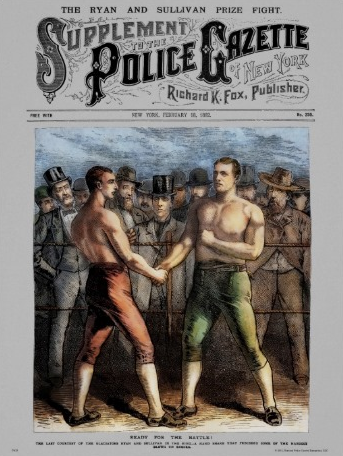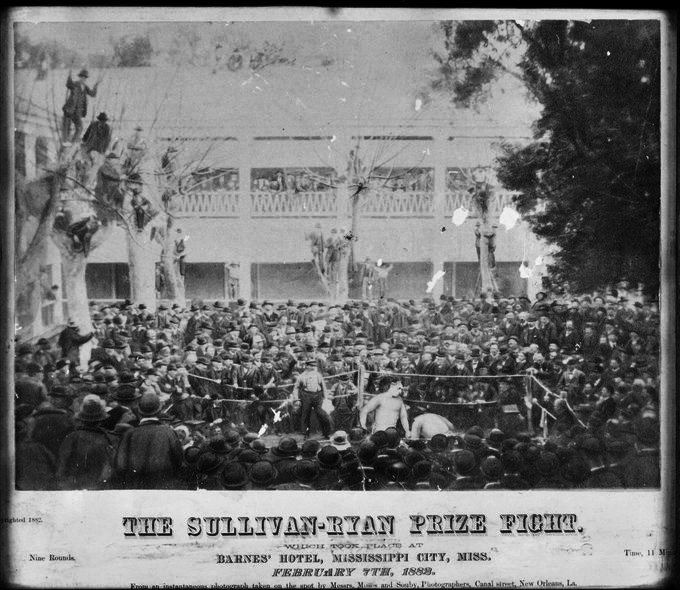Between constant hand and facial injuries and navigating both the prohibition against pugilism and the general public distaste for boxing, being a prizefighter at this time was neither easy or glamorous. Thus, it is not difficult to understand why Ryan went on hiatus from the ring as America’s heavyweight champion, yet the title remained his.
Meanwhile a young Bostonian named John L. Sullivan, who was bankrolled by his manager, trainer and frequent exhibition partner Billy Madden, rose to prominence by defeating the likes of Goss, “Professor” Mike Donovan and John Flood. In 1880, Sullivan sent word through press that he would fight anyone in America for $500, gloves or bare knuckle. And in a time where challenges were often issued through the press for months or years before fights could be gradually financed, this was significant braggadocio.
When a Sullivan vs Ryan match was announced in October of 1881, many expected Ryan, who was also a wrestler, to out-size the challenger, but there were reports the champion had recently suffered a hernia and was made to wear an uncomfortable truss as a result. He was weathered, and it was a fact that didn’t escape him. “My fight with Sullivan will be my last,” he told a reporter shortly after the bout was signed. “I meant to have retired before, but you know how it is. When you whip somebody there is always somebody else turning up that wants to try his hand, and that’s the way I am caught this time.”
Rockaway Beach, not far from his adopted hometown of Troy, New York, was Ryan’s training base, and where he sought to lose weight during the first portion of his camp. Meanwhile, the younger Sullivan, on his way to New Orleans where it was hoped the match would take place, made stops in major cities such as Louisville, Indianapolis, St. Louis and Chicago.
On December 21 a three-round exhibition with Charley McDonald in New York gave Ryan a chance to earn some extra coin and gave his fans an opportunity to give him a proper sendoff prior to his leaving for New Orleans. The following day The Boston World stated, “Mr. Paddy Ryan, the Troy bruiser, is to have a sunburst in his ‘colors,’ but it won’t be a marker to the one that Mr. Sullivan will give him between the eyes.” McDonald, who was billed as the Canadian heavyweight champion, traveled with Ryan and fought him in a number of gloved exhibitions. While both were undoubtedly paid for these events, they also served as a means of promoting the showdown with Sullivan.
Meanwhile, Richard K. Fox, the proprietor and editor of the popular Police Gazette magazine, was Ryan’s financial backer and the publication supported his claim as the true heavyweight champion. Fox told reporters that if Ryan won, he would put up ten grand of his own money to send his fighter to Europe as the Police Gazette champion, making his claim globally undisputed. No doubt the fact Fox and Sullivan happened to hate each other played a factor in all this.

The location of the match was in question right up until it finally took place. The focus shifted from New Orleans to Bay St. Louis, Mississippi, but just when the bout looked to be a lock and Sullivan started training there, the state legislature threatened to pull the plug, forcing the fighters to gravitate back to New Orleans. Indeed when representatives of both camps met at the last minute to hammer out the final details and post the last chunk of their $2500 forfeit, police somehow learned of the deal and attempted to intervene. But business was concluded with Ryan winning the right to choose the location of the set-to: Mississippi City.
It took nine rounds and approximately 11 minutes for Sullivan to vanquish Ryan in an oak grove in front of the Barnes Hotel. Under London Prize Ring Rules, a round ended when one or both fighters were put down, including wrestling take downs. Sullivan drew first blood and decked Ryan with his famed right hand. The champion then wrestled “The Boston Strong Boy” to the ground to end round two. But the exertion of the maneuver sapped Ryan’s energy and he found himself thrown about in clinches thereafter, despite his wrestling background. In the ninth round both men were fading quickly, but a right hand to the side of the head folded Ryan up in a grotesque pile, his jaw badly swollen.

The crowd of some 5000 spectators who dared to show up at the illegal event let out a loud cheer. Sullivan exited the ring with the American heavyweight championship, Richard K. Fox’s support, and a black eye, plus the winner-take-all jackpot. For his part, Ryan claimed he was quitting the fight game altogether, but true to form, decades before it would become an unfortunate stereotype, boxing pulled him back in. He later dismissed the loss to “The Boston Strong Boy,” blaming it on his truss coming undone early in the fight.
The link between the more primitive form of pugilism and the gloved martial art under Queensbury rules that boxing evolved to is Sullivan, while Fox was instrumental in prepping the U.S. public for the sport’s eventual rise to prominence in only a few short decades. And it all started with Sullivan vs Ryan in an oak grove in Mississippi City. — Patrick Connor










